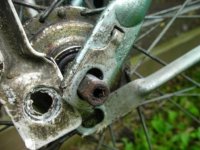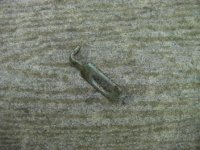jdcburg
100 W
Hi all – I built a front wheel drive e-bike and have completed some testing on it. You can read about the build and see some pix at http://endless-sphere.com/forums/viewtopic.php?f=6&t=12318 I’ve posted one view below. Here’s the basic description from that post: “I acquired a matched pair of old Huffy 3-speed bikes - the kind with the internal gears in the rear axle - what we called an English bike when I was growing up. I put the rear wheel from one on the front of the other with the sprocket on the right so it will engage to drive forward and freewheel when the motor is shut off. I wanted a bike that I could pedal but with an assist for the hills around here (New England). I used a 350W geared down motor from a Razor Dirt Quad over that wheel [Unite MY1016Z3]. Because I decided I would be using the motor at full power and pedaling to start, I ended up using a 40 amp Bosch type relay and a momentary toggle switch. I mounted the batteries (2-12v 12ah sla's) between my legs above the crank.â€Â
The e-drive sprocket (front wheel) is attached to an internal gear 3-speed Sturmy-Archer hub. I have fixed it up so I can shift this hub but did most of the early test rides in 1st gear on the e-drive. The pedal crank is attached to the rear 3-speed hub that I can shift as well. The pedaling cadence when the motor is barely engaged (I can tell by the sound) is about 66 rpm in 1st gear and slower in the other gears. I’ll get back to this in a minute.
I took a 9.5 mile test ride earlier this week. It took me about 45 minutes. It is level then slightly downhill for the first mile, then gradual uphill (about 150 feet vertical) for 4.8 miles, then, on the return, has 2 steeper up and down hills. On this ride I found on level ground and the gradual uphills, I could shift the e-drive hub into 2nd gear and maintain better speed as long as I pedaled. With the rear hub also in 2nd gear, the pedaling cadence at “barely engaged†was (surprise!) 66 rpm. With front hub 2nd, rear hub 3rd , the pedaling cadence was about 45.
The next ride was a 7.5 mile ride out with an 8 mile return. Gradual down for a mile, moderate up for ½ mile then down about 400 vertical feet in 2 miles, with one steep section. The rest (~4 miles) is generally level. I made it down in 32 minutes. I did a good bit of this ride with the e-drive hub in 3rd gear. I don’t have a throttle/controller, just a momentary toggle switch and relay, so I pedaled to get to speed, pulsed the e-drive in 2nd, then shifted up to 3rd. I pulsed it probably 50% of the time through the level sections and nearly 100% on the gradual up inclines. Again, the cadence with both the e-hub and rear hub in 3rd gear is 66 rpm at full motor rpm.
I’m still testing the battery depth, so although there seemed to be plenty of charge, I didn’t want to go back the same way because of the steep section in the middle. I took a route that is about 8 miles back, mostly level for 6 miles then moderately uphill for 2. It took 41 minutes. I pedaled mostly in 3rd, and pulsed the e-drive in 3rd until the final hill. I used full e-assist in 1st and 2nd for that hill and arrived home with what seemed like plenty of battery. I’m using a 12 volt 5 amp auto charger with a built-in ammeter. I reconnect the 2 12v SLAs from series to parallel to charge them. After this ride they charged at 5 amps to start, had dropped back to 4 amps when I checked them at 90 minutes and were at 1 ½ amps at 2 hours.
I guesstimate the e-assist speed at full motor rpm to be 11-12 mph in 1st , 15-16 in 2nd and 19-20 in 3rd. I will try to confirm these with a GPS or maybe with my wife following in the car, although I realize the 2nd choice is risky, given the time I have spent on this project. I thought you all might be interested in the possibility of using gears to increase speed. I wonder if it would work with a derailleur. Hmm… - jd
The e-drive sprocket (front wheel) is attached to an internal gear 3-speed Sturmy-Archer hub. I have fixed it up so I can shift this hub but did most of the early test rides in 1st gear on the e-drive. The pedal crank is attached to the rear 3-speed hub that I can shift as well. The pedaling cadence when the motor is barely engaged (I can tell by the sound) is about 66 rpm in 1st gear and slower in the other gears. I’ll get back to this in a minute.
I took a 9.5 mile test ride earlier this week. It took me about 45 minutes. It is level then slightly downhill for the first mile, then gradual uphill (about 150 feet vertical) for 4.8 miles, then, on the return, has 2 steeper up and down hills. On this ride I found on level ground and the gradual uphills, I could shift the e-drive hub into 2nd gear and maintain better speed as long as I pedaled. With the rear hub also in 2nd gear, the pedaling cadence at “barely engaged†was (surprise!) 66 rpm. With front hub 2nd, rear hub 3rd , the pedaling cadence was about 45.
The next ride was a 7.5 mile ride out with an 8 mile return. Gradual down for a mile, moderate up for ½ mile then down about 400 vertical feet in 2 miles, with one steep section. The rest (~4 miles) is generally level. I made it down in 32 minutes. I did a good bit of this ride with the e-drive hub in 3rd gear. I don’t have a throttle/controller, just a momentary toggle switch and relay, so I pedaled to get to speed, pulsed the e-drive in 2nd, then shifted up to 3rd. I pulsed it probably 50% of the time through the level sections and nearly 100% on the gradual up inclines. Again, the cadence with both the e-hub and rear hub in 3rd gear is 66 rpm at full motor rpm.
I’m still testing the battery depth, so although there seemed to be plenty of charge, I didn’t want to go back the same way because of the steep section in the middle. I took a route that is about 8 miles back, mostly level for 6 miles then moderately uphill for 2. It took 41 minutes. I pedaled mostly in 3rd, and pulsed the e-drive in 3rd until the final hill. I used full e-assist in 1st and 2nd for that hill and arrived home with what seemed like plenty of battery. I’m using a 12 volt 5 amp auto charger with a built-in ammeter. I reconnect the 2 12v SLAs from series to parallel to charge them. After this ride they charged at 5 amps to start, had dropped back to 4 amps when I checked them at 90 minutes and were at 1 ½ amps at 2 hours.
I guesstimate the e-assist speed at full motor rpm to be 11-12 mph in 1st , 15-16 in 2nd and 19-20 in 3rd. I will try to confirm these with a GPS or maybe with my wife following in the car, although I realize the 2nd choice is risky, given the time I have spent on this project. I thought you all might be interested in the possibility of using gears to increase speed. I wonder if it would work with a derailleur. Hmm… - jd




